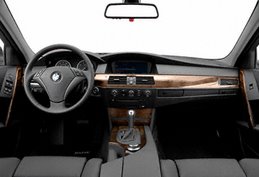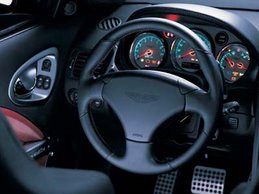 2007 Mazda CX-7 AWD Sport - In any case, it’s beginning to look as if the trend might reverse, with car-based crossovers evolving the species from big old trucks back into carlike wagons. Not completely, perhaps, but in growing numbers. Mazda says it has research to support that contention, particularly among married couples between the ages of 30 and 40 without children. Hence the appearance on these pages of the CX-7, a vehicle that makes considerable use of existing technology to provide the responses and agility Mazda was looking for in its crossover.
2007 Mazda CX-7 AWD Sport - In any case, it’s beginning to look as if the trend might reverse, with car-based crossovers evolving the species from big old trucks back into carlike wagons. Not completely, perhaps, but in growing numbers. Mazda says it has research to support that contention, particularly among married couples between the ages of 30 and 40 without children. Hence the appearance on these pages of the CX-7, a vehicle that makes considerable use of existing technology to provide the responses and agility Mazda was looking for in its crossover.In fact, Koizumi showed us slides of two design proposals: one the way it looks in these pictures and one with a thick, forward-leaning C-pillar. Either would work, we think, but only this one has the tricky kicked-up rear-greenhouse line. Under the swoopy skin are components sourced from other Mazda models. The turbocharged 2.3-liter engine is straight out of the Mazdaspeed 6 but for a revised turbocharger for improved low-rpm response, and it makes 244 horsepower, 30 fewer than in the sedan. The six-speed automatic is shared only with the V-6–powered Mazda 6.
The windshield, for example, has a 66-degree angle, making it the raciest glass in the segment. The steep rake required some relocation of the front-seat occupants relative to the engine compartment, but not enough to turn the Mazda into something like the late and unloved GM DustBuster minivans. It was enough to call for small quarter-vent panes, however, which work well to provide visual continuity with the outside world.
The interior is as deliberately detailed as the outside, with titanium-colored trim framing the instruments,
 center console, and armrests. Soft-feel moldings, carefully tuned knobs and dials, and contoured leather surfaces were selected to match the designer’s vision of craftsmanship, and it’s amazingly good for the price. Even the cloth seats have a fine-grained weave and look like good suit material.
center console, and armrests. Soft-feel moldings, carefully tuned knobs and dials, and contoured leather surfaces were selected to match the designer’s vision of craftsmanship, and it’s amazingly good for the price. Even the cloth seats have a fine-grained weave and look like good suit material.That leather-wrapped hoop is positively connected to the front-strut suspension through a solidly mounted rack, and in our all-wheel-drive CX-7, it felt almost like the helm of a rear-wheel-drive car. That’s quite an achievement in a vehicle that is, in truth, a front-drive car with occasional all-wheel drive. The rear wheels only get to drive when the computer-controlled coupling senses front-to-rear-wheel speed disparities (indicating slippage), and that only happens in low-traction situations. The maximum amount of torque that can be shifted rearward is 50 percent, and the normal operating state is full-on front-wheel drive.
The turbocharged engine works well in this application. Having been massaged to deliver better low-rev boost than in other applications, the Hitachi blower puffs life into the inline-four at low revs, even at comparatively small throttle settings, wafting the car off the line as if it had a V-6 in it. Mazda’s direct-injection system (which pressurizes fuel at 430 to 1600 psi versus a normal port-injection system’s 40-to-65 psi) allows the retention of a fairly high static compression ratio of 9.5:1, and this combines with the low-rev boost to banish virtually any trace of turbo lag or low-down sluggishness.
With 244 horsepower at 5000 rpm, the CX-7 AWD Sport hauled its 3920 pounds to 60 mph in 7.9 seconds and on through the quarter-mile in 16.1 seconds at 87 mph. Those are perfectly respectable numbers, but there are some quicker tall wagons out there, such as the Toyota RAV4 (6.3 seconds to 60 mph) and Subaru Forester 2.5XT (5.9). Ne
 ither of those can match the CX-7’s 0.84-g skidpad figure (Subaru, 0.75; Toyota, 0.79), though. Consider also that we averaged 14 mpg during testing, well below the EPA’s findings of 18/24 mpg.
ither of those can match the CX-7’s 0.84-g skidpad figure (Subaru, 0.75; Toyota, 0.79), though. Consider also that we averaged 14 mpg during testing, well below the EPA’s findings of 18/24 mpg.The rest of the time, the CX-7 acted as if it were a sports car, with well-restrained ride motions, tightly arrested body roll, decisive turn-in, firm and progressive brakes, and eager throttle response. Zoom-zoom, indeed. Mazda ought to find more than a few guys who go home saying, “I changed my mind about that MX-5 and bought this so you and I can both enjoy it.” Hey, buddy, your secret’s safe with us.
The CX-7 is available in Sport, Touring, and Grand Touring versions with either front- or all-wheel drive. Among the various options was one we didn’t expect of a car that starts at $24,310 (four-wheel-drive models start at $26,010), and that was a nine-speaker Bose stereo and power sunroof for $1585. This audio system really kicks, with enough bass response to satisfy the most tone-deaf headbanger.













No comments:
Post a Comment